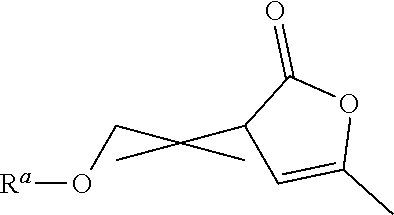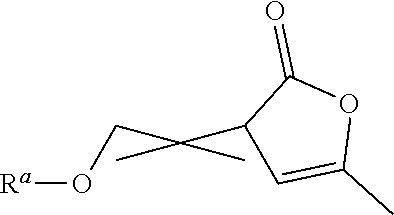Functionalized a- angelica lactone monomers and polymers obtained therefrom
a technology of angelica lactones and polymers, applied in the field of functionalized angelica lactone monomers and polymers obtained therefrom, can solve the problems of poor reactivity of five-membered lactones, lack of literature, and properties that have to date only been realized
- Summary
- Abstract
- Description
- Claims
- Application Information
AI Technical Summary
Benefits of technology
Problems solved by technology
Method used
Image
Examples
example 1
of 2-ethoxymethylene-α-angelica Lactone (EtOMAL)
[0131]179 mL of triethyl orthoformate (1.07 mol) were firstly added to 203 mL of acetic anhydride (2.15 mol) into a 1 L round bottom flask under argon atmosphere and under stirring. 64.4 mL of α-angelica lactone (0.72 mol) and 150 mg of 2,6-di-tert-butyl-p-cresol (BHT) were then added into the flask under argon atmosphere. The mixture was stirred under reflux conditions (T=110° C.-130° C.) and under an argon atmosphere for around 7 hours.
[0132]Five samples were withdrawn during the reaction at respectively 0, 60, 120, 260 and 410 minutes. Between 100 and 250 μL of these samples were added into chromatography (GC) vials containing 30 μL of dodecane used as the internal standard; 1.6 mL of toluene was added into all GC vials and the obtained solutions were analyzed by GC-FID. The relative amount of α-angelica lactone was calculated by the ratio between the integration areas normalized with respect to the internal standard and with respec...
example 2
olymerization of EtOMAL
[0138]
example 2.1
nd Characterization of Poly-EtOMAL Using Sodium Isopropoxide (NaiPrO) as the Catalyst
[0139]2.1.1 Synthesis
[0140]800 mg of EtOMAL was dissolved in 1 mL of toluene under inert conditions. The solution was added to a mixture of 4 mg of NaiPrO and 1 mL of toluene at 60° C. under an inert atmosphere. Additional toluene (1 mL) was used to quantitatively transfer EtOMAL into the reaction mixture.
[0141]Shortly after the addition of EtOMAL a solid material in the form of a gel started to precipitate. The reaction was left for 2 hours at 60° C. Afterwards around 1 mL of an aqueous HCl (0.1 M) solution was added into the reaction Schlenk vessel. The solid was then washed several times with toluene. Afterwards the washed solid was dissolved in dichloromethane and filtered through a short column of SiO2. Finally, it was dried overnight under vacuum. Overall yield was typically higher than 90%.
[0142]2.1.2 NMR Characterization of Poly-EtOMAL
[0143]The product was characterized by Nuclear Magnetic R...
PUM
| Property | Measurement | Unit |
|---|---|---|
| Temperature | aaaaa | aaaaa |
| Percent by mass | aaaaa | aaaaa |
| Molar mass | aaaaa | aaaaa |
Abstract
Description
Claims
Application Information
 Login to View More
Login to View More - R&D Engineer
- R&D Manager
- IP Professional
- Industry Leading Data Capabilities
- Powerful AI technology
- Patent DNA Extraction
Browse by: Latest US Patents, China's latest patents, Technical Efficacy Thesaurus, Application Domain, Technology Topic, Popular Technical Reports.
© 2024 PatSnap. All rights reserved.Legal|Privacy policy|Modern Slavery Act Transparency Statement|Sitemap|About US| Contact US: help@patsnap.com










